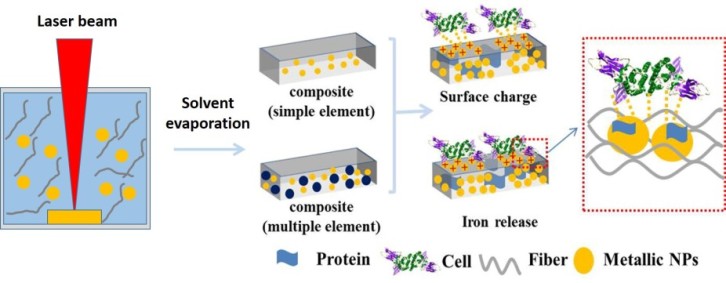The idea of laser ablation in monomers and polymer solutions opens an alternative route to the fabrication of bioactive nanoparticle polymer composites adopting the nanomaterial to the therapeutic window determined in vitro. Homogeneous and non-agglomerated multimaterial nanocomposites are rapidly manufactured using the laser method. Upscaling the productivity enables the fabrication of semi-finished goods, via extrusion or automated injection moulding. This gives access to small series fabrication of devices for nanomedical application. The main advantage of laser fabricated nanoparticles in this context is the easy processing of multiple nanoparticle types and the efficient matrix coupling due to the absence of organic stabilizers. In case of hydrogel-based nanocomposites e.g. alginate the generated nanoparticles may be used in 3D-printing applications. The embedded nanoparticles may enhance the cytocompatibility of the composite materials due to:

- Metal ion release which may favor wound healing (Fe, Zn) or exhibit antimicrobial properties (Ag, Cu)
- Alteration of the surface charge from a hydrophobic to a hydrophilic environment (Pt, Au)
Our main research goals and interests are:
- Understanding the mechanisms by which nanoparticles of various materials alter the interactions between cells and polymers aiming at novel biomaterials.
- Collaboration with partners from biology and medicine evaluating laser-generated nanocomposites for e.g. tissue engineering materials, wound dressings or medical devices in vitro and potentially also in vivo and in the clinic.
- Exploring the suitability of laser-fabricated nanocomposites for 3D-printing
References:
[1] Li, Y. Y.; Ramesh, V.; Bider, F.; Bradshaw, N.; Rehbock, C.; Boccaccini, A. R.; Barcikowski, S. Co-doping of iron and copper ions in nanosized bioactive glass by reactive laser fragmentation in liquids. Journal of Biomedical Materials Research Part A (2022), 110, 1537-1550.
[2] Richter, A.; Li, Y.; Rehbock, C.; Barcikowski, S.; Haverich, A.; Wilhelmi, M.; Boer, U. Triple Modification of Alginate Hydrogels by Fibrin Blending, Iron Nanoparticle Embedding, and Serum Protein-Coating Synergistically Promotes Strong Endothelialization. Advanced Materials Interfaces (2021) 8.
[3] Li, Y.; Rehbock, C.; Nachev, M.; Stamm, J.; Sures, B.; Blaeser, A.; Barcikowski, S. Matrix-specific mechanism of Fe ion release from laser-generated 3D-printable nanoparticle-polymer composites and their protein adsorption properties. Nanotechnology 2020, 31, 405703-405703.
[4]Brändle, K.; Bergmann, T. C.; Raic, A.; Li, Y.; Million, N.; Rehbock, C.; Barcikowski, S.; Lee-Thedieck, C. Iron Nanoparticle Composite Hydrogels for Studying Effects of Iron Ion Release on Red Blood Cell In Vitro Production. ACS Applied Bio Materials 2020.
[5] N. Million, V. Coger, P. Wilke, C. Rehbock, M. Vogt Peter, A. Pich, S. Barcikowski, Water-based, surfactant-free cytocompatible nanoparticle-microgel-composite biomaterials – rational design by laser synthesis, processing into fiber pads and impact on cell proliferation, in: BioNanoMaterials, 2017.
[6] A. Blaeser, N. Million, D.F.D. Campos, L. Gamrad, M. Koepf, C. Rehbock, M. Nachev, B. Sures, S. Barcikowski, H. Fischer, Laser-based in situ embedding of metal nanoparticles into bioextruded alginate hydrogel tubes enhances human endothelial cell adhesion, Nano Res., 9 (2016) 3407-3427.
[7] C. Hess, A. Schwenke, P. Wagener, S. Franzka, C.L. Sajti, M. Pflaum, B. Wiegmann, A. Haverich, S. Barcikowski, Dose-dependent surface endothelialization and biocompatibility of polyurethane noble metal nanocomposites, J. Biomed. Mater. Res. Part A, 102 (2014) 1909-1920.

